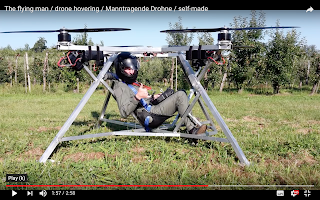The project would be lost without these models, and after sketching the alternatives in bed I pull apart yesterday's effort, with all of its motors top-mounted on the cantilevers.
I realise that mounted in this way the clearance between overlapping blades is determined only by the depth of the spars forming the cantilevers, which is too close for comfort.
Too close because:
(a) the tips of the propellers are likely to flex upward, reducing the margin and...
(b) ...the spars themselves will be subject to flexure or twisting, reducing it further.
It thus appears that despite my aversion to under-slung motors there is an advantage in the arrangement in the photograph, in that it increases the gap between the propellers without adding to the overall depth of the airframe.
I also recall a research paper suggesting that increasing the gap between control-rotating blades increases the thrust ~ I guess because the efflux from the upper disk has more time to contract, to provide a greater volume of 'fresh' or unaccelerated air to the lower propeller.
The scale is unchanged from the previous at 1:5 and still features the 50cm square deck and 100cm spars, to which 32" propellers are attached. The motors have been reduced in size after I check the specs and see that they are only 10cm or 4" in diameter.
The hole is just over a foot wide at full scale and designed to accommodate a pilot-operator, although there is no reason why a powered rig of this kind could not be incorporated in the outline of a 'flying phone-box'.
Priority is to get it built, including the aperture, and give it a whirl.
















